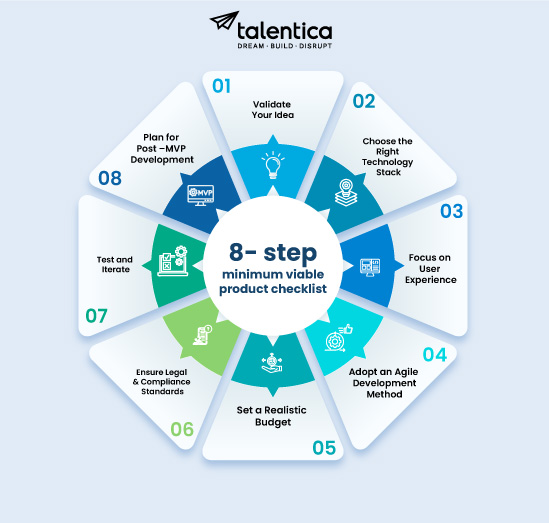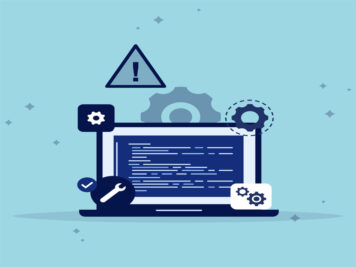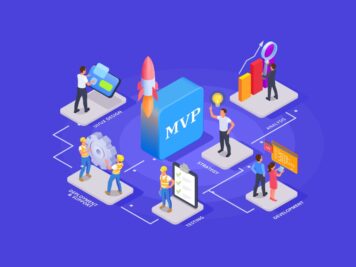Startups have a high failure rate of 90% [1]. They fail mostly because of a lack of market need for their product. A survey by CB Insights highlights this further [2]. As per their report, 42% of failed startups create products or services that do not address a genuine market need.
Cold statistics like this aim to inspire, not discourage, entrepreneurs to work more efficiently. They also make validating your idea with MVP crucial. However, developing an MVP that resonates with customers is challenging. To help, we have put together an 8-step minimum viable product checklist in this blog. This checklist can help you understand the developmental process but before advancing let’s cover the fundamentals of an MVP and its preliminary considerations.
Understanding MVP and its relevance
Eric Ries and Steven Blank coined the term “Minimum Viable Product” in The Lean Startup Methodology, to describe a specific version of a product that allows a team to collect the maximum amount of validated learning about customers with the least effort.
Why does MVP matter?
Well, for startups, it is a low-risk strategic approach to validate future startup product success in agile product development. The MVP approach is like a cycle: build something simple, measure how it is doing and learn from it. This critical feedback loop helps startups to quickly identify any shortcomings in their product and make necessary improvements to find product-market fit.
The main goal of an MVP is to provide immediate value, gather data, feedback for future improvements, and keep development costs low. This iterative, agile process also offers other benefits such as:
- Getting your product to the market fast.
- Testing your idea with real users before spending a large amount on complete development.
- Understanding what your target customers like or do not like.
- Testing product features to see what fits the market demographic the most.
Amazon exemplifies the importance of an MVP. Founder Jeff Bezos initially envisioned a vast online marketplace that would sell everything. He recognized challenges like limited web users, no global supply chain, and people’s uncertainty about online shopping safety quite early. It prompted him, and his team to limit their scope.
They evaluated the market by shortening the list to five items, with books being the chosen category. The first version of Amazon only included website, a list of books, and Jeff managing the orders himself. That was it – the Amazon MVP. As the website began generating revenue and attracting customers, it became clear that people were ready to shop online. This small beginning set the stage for Amazon to become the giant it is today.
We did something similar for one of our clients, Amplify.ai, an AI-powered product. We helped them pivot to find the right market fit. The initial idea was centered around improving brand engagement with customers by using social media channels. The product grabbed attention. But the company wanted more features to make it worthwhile. So, we kept improving the product together using the MVP approach to find the best fit.
We made some changes to make sure their idea worked in different markets by adapting the product for a broader customer base. Once they found the right fit and people loved it, they got support from investors and even witnessed a successful acquisition.
Preliminary considerations for MVP development
Developing an MVP begins by understanding why your product should exist. The following questions can help you with that
- Are you addressing a unique and significant problem?
- Are people already trying to solve this problem in a unique way?
- Do you have the best team to solve this problem and build the product well?
If your answers are affirmative, then you are on the right track to start the MVP development process.
Identifying core functionality
If you have identified a significant problem and have the solution, start planning how your product will make a real difference for users. Ask yourself whether your product can simplify complex tasks or can it improve productivity/efficiency or perform other functionality.
For non-technical founders or those lacking startup expertise, consulting an experienced technical team is invaluable. Together, they can conduct workshops to groom user stories and identify key functionalities to attract potential customers.
Properly defined core functionalities help communicate your product’s value to users and keep the MVP focused on delivering them.
Conducting market research
Market research provides data on market dynamics, industry trends, customer behavior, and competitor analysis, which you can use for a full picture of the target audience.
There are two ways to gather information: via primary research (direct data collection: F2F interviews, market survey, etc.) or via secondary research (existing data: industry reports, libraries, etc.).
For competitor analysis, start by identifying competitors offering similar services or having the same product. The best way of finding them is through market reports, review sites such as clutch or G2, and social media platforms such as LinkedIn.
As the next step, do a SWOT analysis – identify what you are good at, your weakness, what makes you unique and where your competitors excel. This analysis will help you plan and create your MVP step by step.
Talentica’s 8- step minimum viable product checklist
For startups, the product development process is extremely time- and resource-sensitive, leaving no room for mistakes. This is particularly crucial when developing an MVP. The target audience will either find it valuable or dismiss it. Starting with a comprehensive checklist is a smart approach to minimize the risk of failure. Plus, knowing the correct steps simplifies the process of building your MVP.

Step 1: Validate your idea
Don’t start building your product immediately; first, check and ensure there is a demand for it. Startups should prioritize this step before building an MVP to avoid wasting resources on something the market doesn’t need.
Here’s how you can do it: Share your ideas with potential customers and gather critical feedback to check whether they need a product like yours at all. For example, if you are thinking of developing a new SaaS application for people who love fitness, reach out to them and, convey your idea. Ask what they think about the idea, how you can make it better, and whether they are ready to pay for that application.
For more insights on creating a SaaS MVP and understanding its critical elements, read our complete guide on SaaS MVP Development.
You can also gather specific user feedback using online communities like fitness forums, social media platforms like Quora and LinkedIn to validate your idea. Once you have the necessary insights and hear positive responses from your users, find out the right technology stack to build the MVP.
Step 2: Choose the right technology stack
Choosing the right technology stack is crucial for building, testing, deploying, and maintaining consistency of software experience. Start by identifying the features and functionalities your product requires. The process should always include considerations such as scalability, development time and your teams’ expertise.
If you have a unique product, conducting a Proof of Concept (POC) is essential. POCs are an excellent way to understand technological requirements and limitations as they provide a comprehensive overview of what will work and what won’t. If your product has competition, researching successful products in the same domain and analyzing their technology, differences, and customer impact can help you understand what might work for your product based on proven success.
Also, choose a tech stack based on your project size- small, medium, or large since choice of technology stack can vary. Opt for popular options like MERN, MEVN, MEAN, server less, PERN, LAMP, and Ruby on Rails for creating websites and web applications. Don’t go for rare technology with scarce talent; stay updated with popular trends and latest tech stacks within user communities. This approach will make sure your project has a solid foundation.
Step 3: Focus on user experience
Building a user-centric product involves putting yourself in the shoes of different users. Their satisfaction is your top priority. To do this, you can do research to identify user types, investigate each users’ perspective and understand how they will be using your product.
You can also think about the goal a user would have- whether it’s buying, searching, or ordering something- and consider what they feel during these stages. This will help you to figure out the initial features for the first version of the product that matter most to users, making sure it hits the right notes from the start.
Adopting a product mindset is the key. Prioritize features that are relevant to your business goals and measure their impact to optimize development. Continuously gather customer feedback and iterate your product using data-driven insights. By integrating user experience with business goals, you can design a product that not only delights users but also drives results.
Step 4: Adopt an agile development method
There are different approaches to product development, such as Waterfall, Kanban, and Scrum, but the Agile approach excels in developing MVPs. It can help you reach quickly to your customers.
Other approaches are less flexible and more documentation oriented. Agile, on the other hand, is scalable and keeps the development simple by focusing on core features received via customers’ feedback. This saves time and resources, making solutions reach users faster.
With Agile, you can make rapid iterations, break development process into small steps with specific goals. It also facilitates collaborations among teams and streamlines the entire development process.
Step 5: Set a realistic Budget
An MVP costs less than the complete product, but it still comes with a hefty price tag. Failure could result in significant setbacks in terms of funding and resources.
Founders sometimes opt for in-house development due to benefits like better communication and stronger relationships. However, this approach has drawbacks, with cost being a major one. Offshore MVP development service providers are often much cheaper than in-house teams. If the budget is tight, hiring an offshore team is the most feasible option.
Additionally, an experienced tech partner can add valuable insights from past MVP developments. This can be hugely beneficial for you if you lack a dedicated CTO or are a first-time founder.
Step 6: Ensure legal and compliance standards
Compliance with laws and regulations protects individuals and businesses from fines and legal consequences. Understanding the legal environment is crucial while developing an MVP, particularly when dealing with sensitive user data or operating in regulated industries.
Familiarize yourself with key regulations like GDPR, HIPAA, and DORA. Do not overlook other important regulations such as SPOC (single point of contact) requirements and NDAs to protect sensitive information. By integrating these compliance measures from the start, you can avoid costly adjustments later.
Ethical considerations are often overlooked but they are equally important. Transparency in data use and unbiased AI algorithms are key to maintaining a good reputation. Neglecting these aspects can damage customer trust.
Meeting legal and compliance standards highlights your commitment to ethical practices, earning the trust of customers, investors, employees, and regulators. A good reputation makes your brand more valuable and opens more business opportunities.
Step 7: Test and iterate
Test the MVP thoroughly to identify and fix bugs, glitches, or any issues. You can opt for usability tests with real users to see how they interact with the product and find areas for improvement. It is also good to ensure your MVP handles expected loads and works well under different scenarios.
You can offer early access or a beta version to a small group of users to gather additional feedback, which you can then use to make smart decisions and keep improving the product over time.
Remember, while testing is essential, so is time- to- market. Prioritize critical issues and iterate quickly to maintain momentum. Avoid getting bogged down in unnecessary delays.
Step 8: Plan for post –MVP development
The post -MVP process is not an easy one. The journey from first product launch to achieving product-market fit is a long way. It must have a growth strategy with financial liquidity and the right team to scale the product effectively and meet customer preferences.
You should also constantly innovate and enhance the product, add new features, and improve overall user experience based on feedback and market demands.
Post -MVP: Next steps
Gathering user feedback and validating the market are crucial for the future as they can significantly impact the product development process.
Analyzing MVP performance and user data
Learning from an analytical study of your delivery and comparing your conclusions with real market responses is important. In other words:
- Check what your product has become on the market.
- Analyze how the product is performing and what impact it is having.
- Compare your results with user’s opinions and adjust if needed.
Planning for scaling up
If your MVP is a success, then you should plan for scaling up your digital product to meet the growing user base and their evolving needs.
However, this is not easy as it requires not just enhancing the product but also adapting the business strategy as per requirements. To do this successfully, focus on your core strategy, stick to your project vision, set up efficient processes, and have a skilled tech team on board.
This way, you’ll be able to meet your users’ needs and acquire new customers.
Adding features based on feedback
The quantitative analytics of the user feedback helps identify the most important new features. You can then make changes to the product and test it again. This approach ensures that your product not only succeeds but keeps improving over time with the flexibility it needs.
Conclusion
Building an MVP is an easy way to enter the market and build customer trust. By providing value and continuously improving your product, you can differentiate yourself within the market. The above article focuses on the importance of understanding that MVP is a process and provides a helpful checklist for entrepreneurs to make it easier. It does not matter if you have a basic idea or a documented prototype; you can always consider an MVP development company.
If you are considering MVP development, you can contact our experts for your project. At Talentica, we have a proven track record of building 180+ tech products for startups over the last 21 years. We help startups and businesses choose technology, set up the right architecture, and use emerging tools and trends, all while keeping the product vision intact.
FAQs about MVP Development
In which stage is a minimum viable product (MVP) created?
When creating a new product, the MVP is like a test version, and it is built during the 3rd stage of the six- step product development process, specifically the prototyping stage.
What is the purpose of a minimum viable product?
The primary purpose of the MVP is to check if the initial idea about the product is right by using real-life data. Also, it helps save time and money by launching the product faster while improving the product along the way.
How do you build a minimum viable product?
To build an MVP, follow five steps:
- Do market research.
- Set goals and identify your target users.
- Pick features and functions that matter most to the users.
- Developing MVP.
- Get feedback from users and analyze the results.
What comes after a minimum viable product?
After the MVP, the next step is to build a Minimum Marketable Product or MMP.
What are the requirements of a minimum viable product?
The key requirement for an MVP is to focus on core functionality that solves real market problems.
What should an MVP include?
An MVP should include these three key parts:
- Understanding users
- Having a basic set of core features
- A Feedback loop for gathering and acting on user feedback.








